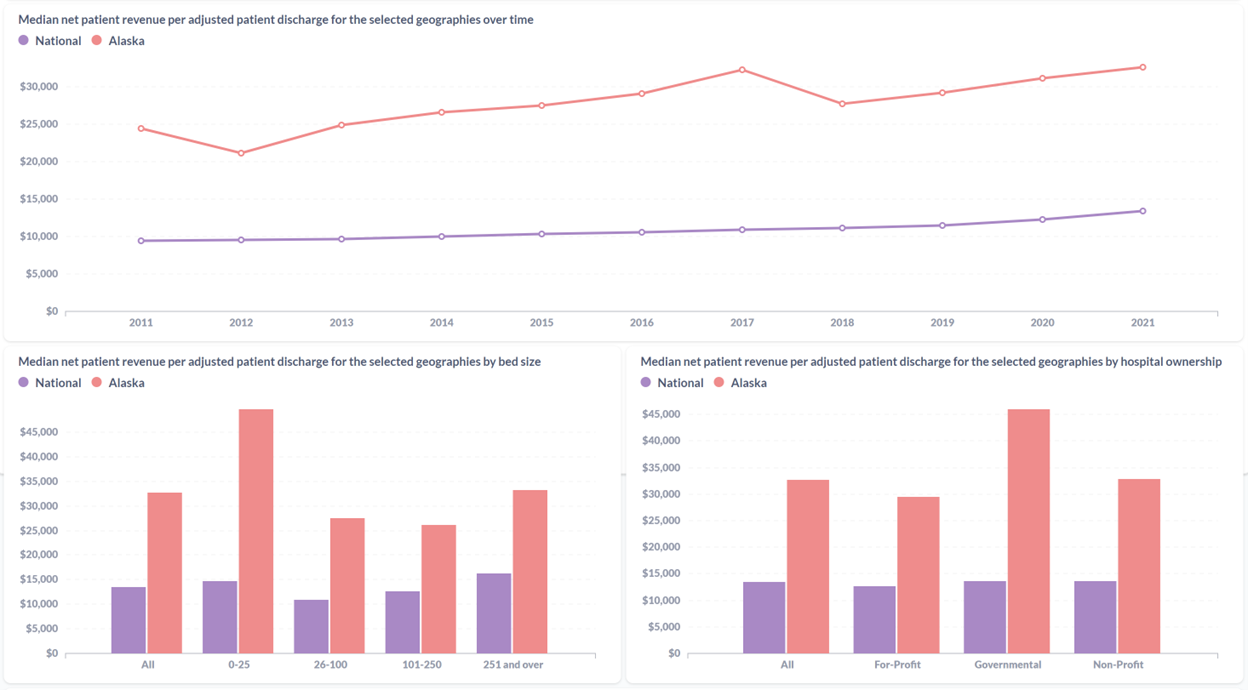
By Quinn Townsend – Alaska Policy Forum
Health care costs across the nation, and especially in Alaska, are skyrocketing. Due to the state’s vastness and small population, healthcare facilities are concentrated in the state’s high-population areas, limiting access for those in remote areas. In addition to remoteness, Alaskans must contend with the consequences of Certificate of Need (CON) laws, which further limit the number of care facilities in the state and the services they can provide. Although policymakers can’t change the size of the state, they can repeal CON laws to increase care facilities and services available to Alaskans.
One Alaska CON law restricts the number and type of beds hospitals and other care facilities can have. The state has restrictions on general medical-surgical beds, pediatric beds (including NICU bassinets), intensive care beds, acute rehab beds, and obstetric beds (which include birthing and recovery rooms in general). This means that a hospital in Alaska must obtain permission from the government, and with input from other competing hospitals in the same region, to add additional beds to its facility.
In response to the COVID-19 pandemic in 2020 and 2021, however, CON hospital bed restrictions were temporarily lifted in Alaska and 24 other states. Even with the temporary lifting, hospitals reportedly struggled to make room for patients during the height of the pandemic in Alaska (see photo on right), and many patients without COVID-19 but still sick or injured were unable to get the care they needed. More beds and facilities (and the workers to staff them) could have been beneficial during those times of uncertainty.

Unfortunately, that directive was temporary, and all CON laws are again in place. Permanently repealing CON laws such as the restriction on hospital beds would allow care facilities to respond more quickly to the needs of their patients — without having to wait for government permission to do so. Rather than changing policies reactively after emergencies start, it would be better for all involved to simply remove the policies now.
Research has shown that rural states with CON laws have fewer hospitals per capita. In fact, using data from 2016, researchers have found that, based on total population numbers and health data, Alaska could hypothetically have up to 10 more hospitals and two more ambulatory surgical centers if the state repealed its CON laws. This would result in an increase from 25 hospitals to 35, which could significantly increase Alaskans’ access to health care and decrease the distance some must travel to receive care.
Of course, no other state is as large, or has its population spread out as much as Alaska. One factor the researchers did not take into consideration was the distance between population centers. While there may not be ten additional communities in Alaska with the workforce to staff new hospitals, the research does clearly show that it would be easier for a new hospital or ambulatory surgical center to be established if CON laws were repealed and that there is a need for better (and more) health care access in Alaska.
In fact, according to data collected by the Kaiser Family Foundation, there are only 2.24 community hospital beds per 1,000 Alaskans in the state. The US average is 2.37 beds per 1,000 people — not much better. In comparison, South Dakota and North Dakota (rural, sparsely populated states) have some of the highest beds per 1,000 people, with 4.75 and 4.41 beds, respectively. While there are certainly multiple factors affecting the number of hospital beds in a state, neither South Dakota nor North Dakota have any CON laws, and both states had repealed their CON laws by or before 2000.
Altogether, CON laws in Alaska restrict:
— Ambulatory Surgical Centers (ASCs)
— Burn Care
— Cardiac Catheterization
— Computed Tomography (CT) Scanners
— Hospital Beds (Acute, General Licensed, Med-Surg, etc.)
— Intermediate Care Facilities (ICFs) for Individuals with Intellectual Disabilities
— Linear Accelerator Radiology
— Long-Term Acute Care (LTAC)
— Magnetic Resonance Imaging (MRI) Scanners
— Mobile Hi Technology (CT/MRI/PET, etc.)
— Neonatal Intensive Care
— New Hospitals or Hospital-Sized Investments
— Nursing Home Beds/Long-Term Care Beds
— Obstetrics Services
— Open-Heart Surgery
— Positron Emission Tomography (PET) Scanners
— Psychiatric Services
— Radiation Therapy
— Renal Failure/Dialysis
Health care costs in Alaska are much higher than most of the nation and repealing CON laws to allow more health care access would also help reduce some costs. In 2021, the most recent year with data, the median hospital operating cost per patient in Alaska was almost $14,000 more than the national median. On the other hand, that same data also shows that in Alaska, the median hospital revenue per patient is over $19,000 more than the national median. Additionally, both non-profit and governmental hospitals in Alaska have a higher median revenue per patient than for-profit hospitals. If hospitals in Alaska are experiencing such high revenues above and beyond their high costs per patient, this may be a sign that there is room in the market for additional health care services and facilities.

CON laws, which were originally implemented to improve access to healthcare and reduce costs, had the opposite effect. Research shows that, particularly in rural areas (such as most of Alaska), CON laws have restricted access to healthcare. Expanding the opportunity for additional care facilities, more hospital beds, and additional services without government permission would certainly improve health care access and reduce costs. At least 15 other states have repealed their CON laws; it is time for Alaska to do the same.
The views expressed here are those of the author.







6 Comments
So I read this as we need to lobby our elected officials in Juneau to drop the CON law and it MIGHT help with are over paying for hospital stays and medication. It eill get rid of some of tge greed factor. Am I correct? Anyone please respond.
I don’t think greed is the same thing as good business practice. Hospitals are not charities, although they perform as charities for some, by law. The CON laws serve no good purpose currently and should be revoked. You know it’s bad when your insurance will pay for you to fly to Seattle or wherever, stay in a hotel, and get medical care at the lower price there than here. This is really a no-brainer, until you find out which politicians benefit from the high costs of health care.
Tamra I’m sincerely sorry you lost your dad due to the Covid shot. I have been stating loudly to the fact that our leaders are not trustworthy but are outright liars. Unfortunately victims like your precious father are caught up in the mess. I’m doing what I can and am determined to bring dunleavy,zinc,Crum into full public view! The church must also be heavily invested in this battle or simply bow out because they have become complete cowards!
I may not be politically correct and rough around the edges, but these are not times for polishing bs we need to eradicate the bs!
One of the main things that is fueling health care costs in the U.S. is the amount of money the pharmaceutical industry spends on advertising. Watch a couple hours of network news on TV, and count the number of splashy, well-produced commercials for prescription drugs you see. And often for medications that relatively few people have any need for! “If you’re blind and are losing your sense of time, ask your doctor if Xenoxytrab is right for you!” There was a time 50 years ago when drugs were only advertised in publications that only doctors read, like “JAMA” and “Medical Economics.” My late father was a doctor, and he was angry when he started seeing commercials for prescription meds on TV. In the European Union, such commercial promotion is prohibited.
What you just said makes no sense Chuck. How can you tie pharmaceutical advertising to healthcare costs?
Do these costs include the Free Native Hospital costs.
Why do people who receive free Native Healthcare eligible for State of Alaska Medicaid. This was not true prior to Walker implementing Obama care in Alaska. Track the cost of State Medicaid since that date. How does that factor into the overall State of Alaska SOA health care costs?
Note SOA Medicaid benefit’s are far more generous than Federal benefit’s. Big Time.
One point the article presumes is that there are Doctors that want to practice in Alaska. A huge Assumption. Just because you can pencil the numbers and say it real fast, does not make it a reality. With many professional roles, Alaska has not only has a hard time attracting people, in fact Alaska is exporting professionals.
Medical care as with just about everything else in Alaska will be more expensive that the lower 48 and always will be.